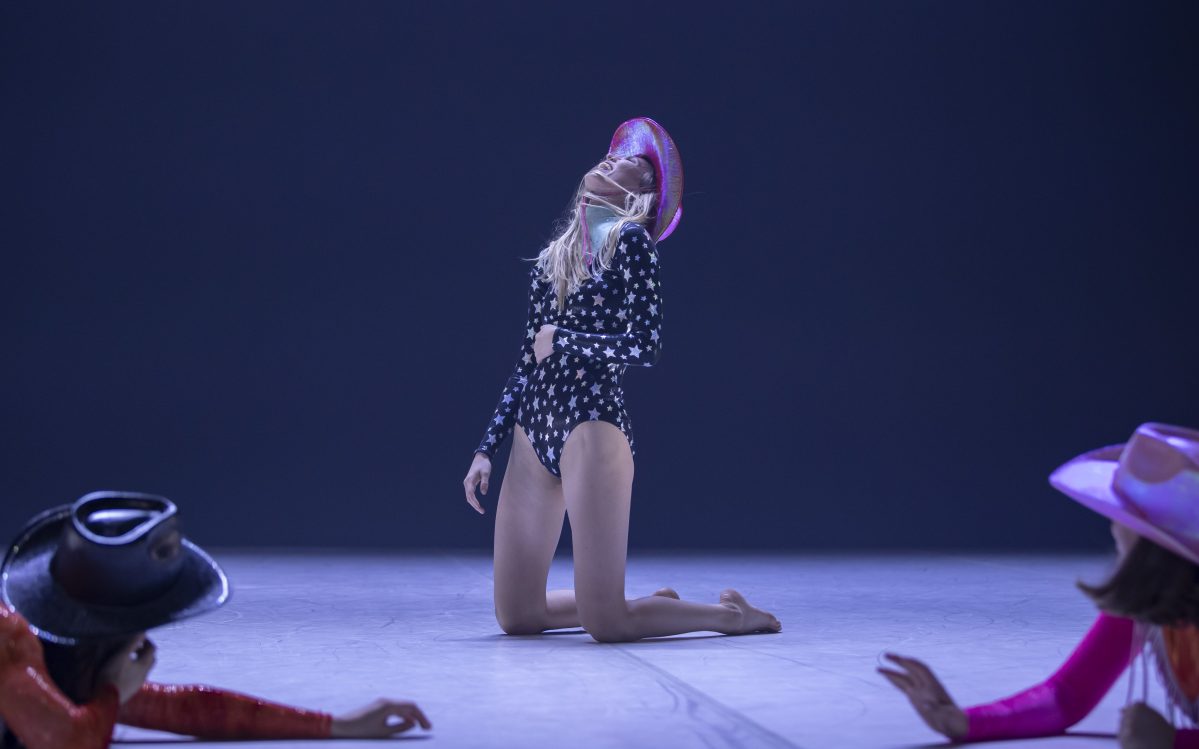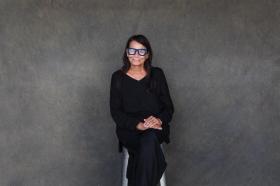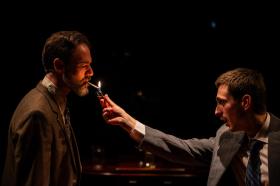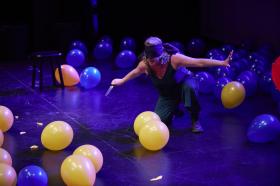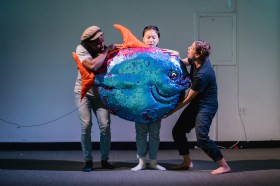Contemporary dance should always crest the lines of performance art, movement and storytelling. When done well, it soars as a form of narrative. In its 10th edition, Sydney Dance Company’s New Breed captures the cultural “why” of each choreographer’s intent across four individual works with a resounding conclusion.
Everyb0dy’s g0t a B0mb speaks to the conflict (and aesthetic value) of resistance from the angle of Woodstock ‘99. Everyone is outfitted in the utilitarian casual of the festival heyday, and holds a huge, moving placard that is emblazoned with unintelligible graffiti. The placards later become wielded as pithy demonstrations, when the structure of the number starts to disassemble into chaos. Riley Fitzgerald’s piece is influenced by the concept of “collective effervescence”, which is taken on in this piece as a miasma of undirected rage and primal behaviour. The dance could have existed in the Berghains of the world, but it is unclear why we would want it to.
The movement is static, heaving with bile, yet its intensity is less tied to the subject matter than the explosiveness of the choreography. We remember then that it is every man for himself, and that is reflected here tenfold. Bodies are crumpled, skittered across the floors, contorted in frenetic embrace and, later, disrobed brazenly, a battering call to upheaval. Fitzgerald transposes the idea of collective resistance through the funnel of the Bacchanalian gone wrong — see how groupthink leads to mayhem? If we remember that the piece intends to take the flinty, drug-induced rage of the youth and fling it in our faces, then it serves it up well with a surprising neutrality towards the event that inspired the ruckus.
Belonging to the same multiverse of Thelma and Louise and the fuchsia-toned, roller-blading Barbie of 2023, Revenge Tales and Romance is Eliza Cooper’s take on the perennial Old Western. The epic relies strongly on the bravado of the five female performers, who jockey across the stage with a knowing jauntiness – they are central to upholding the smoke and mirrors of the very landscape they are trapped within, and yet they are gleeful in captivity.
The dance is in two main segments: the first is a voyeur’s look behind the scenes. The women are stationed like troops across a bare, white-lit stage, cycling through vocal exercises and stretches as they test the limits to their comportment. With the exception of one brunette, they are very blonde, white and bedazzled.
The second segment is where the story and the persona splits, revealing the bloodied underside to the Western. The cowgirls become hyenas, the feminine form fracturing in an exhilarating show of bodily exploitation and sexuality. The dancers prowl and leap, and yet the girlish feint of their initial performance seeps into the savagery. Under a red orbed stage, the figures are still distinctly feminine: the female form and how far it can be bent to will is spotlit on purpose. Cooper wants to ask, “Is it superficial?” And the answer is an emphatic, coquettish lisp: maybe so.
Tra Mi Dinh’s Somewhere between ten and fourteen is a portrait of change. The piece is a diminutive look inward, chronicling the uncertain hours that chase day into night with a slow, pulsating build-up. The dancers are clothed in a luminescent blue, and their movements are firm and elastic. For a piece on the vague segueing of time, it lags a little in agency. Drawn up in comparison to the other acts, it is harder to distinguish when the language of the dance itself is trying to communicate outside of the temporal.
What brings the piece back to the fore is the moment in which the dancers all unlace their shoes one by one and take turns lying belly-up, visibly panting before they resume the act with even more energy in densely executed movement. Credit should be given to Tilman Robinson’s sound design, which works well to pierce this barrier of the unknown, propping up the seamless choreography with a meatiness that the piece needs. At 22 minutes, Somewhere between ten and fourteen is more of a lilting decrescendo in terms of impact, but as an intended exploration of dusk warming into dawn, maybe this works with the scaffold of Dinh’s vision.
Through the words of Jeff Wayne’s The War of the Worlds, Gubba starts with a self-fulfilling prophecy:
And yet, across the gulf of space
Minds immeasurably superior to ours
Regarded this Earth with envious eyes
And slowly and surely, they drew their plans against us
From the perspective of white settlers, Beau Dean Riley Smith takes us through the frontier wars and the seepage of colonialism that has built “Australia”. It is a Björkian narration of imperialism replete with a partially nude, gender-fluid mother Alien Host. The remaining dancers are her colonial subjects, cavorting at her command and later being subsumed into a giant, floating skirt, which moves her with impressive ease. The settlers are painted ghostly white with black smears for mouths. They sling Dion Lee reminiscent satchels, which at points become extensions of weaponry and limbs alike.
There is the arrival, the establishment of the New World Order, and the depths undertaken by the settler project to ensure that this treatment remains in place. The most provocative segment of the piece involves the slow indoctrination of one of the dancers, who visibly struggles through the abstract of violence that is enacted before them. In silence, the group descends upon the solitary defector with catastrophic jeering when the single dancer finally manages to take aim at a lurking target. The sound of the gun is absent, but inferred from the riotous din as the group swarms upon the indoctrinated.
Smith captures moments of pearly terror through the unfolding of group movement, and the pace of the choreography is adept at masking the brutality that unfolds before us. The finale reassembles a now exultant Mother Host holding court before her subjects on the newly plundered land, ending with an alien subject, who joins the crowd in clapping. Years later, we celebrate the destruction of Indigenous land with composure and clean hands. Gubba is unafraid of the ugliness of its subject matter, and leans into its perversion to tell the most important tale of this nation.
A quartet of exacting proportions, New Breed at Carriageworks is an impactful program not just in name but in narrative. This year’s season is an unwavering show of talent among the newest in Australian Dance.
New Breed 2023 is showing at Carriageworks from 6-16 December. Tickets.
This review is published under the Amplify Collective, an initiative supported by The Walkley Foundation and made possible through funding from the Meta Australian News Fund.
